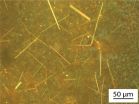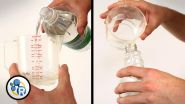Warming seas pose habitat risk for fishy favorites
2015-04-13
(Press-News.org) Popular North Sea fish such as haddock, plaice and lemon sole could become less common on our menus because they will be constrained to preferred habitat as seas warm, according to a study published today in Nature Climate Change.
Fish distributions are limited by water temperature and some species can only thrive in certain habitats and depths. In the last 40 years the North Sea has warmed four times faster than the global average and further warming is predicted over the coming century, leading fisheries scientists to study how this will impact on commercial species.
The researchers developed a model that combined long-term fisheries datasets and climate model projections from the Met Office to predict the abundance and distribution of the UK's favourite fish over the next 50 years.
The team including researchers from Exeter and Bristol found that, as the North Sea warms, species will have little capacity to move northwards to avoid warming temperatures, since habitat of a suitable depth is not available. Due to higher temperatures, many of the species studied are predicted to reduce in relative abundance.
Louise Rutterford, postgraduate researcher at the University of Exeter, said: "Our study suggests that we will see proportionally less of some of the species we eat most of as they struggle to cope with warming conditions in the North Sea. We provide new insight into how important local depths and associated habitats are to these commercial species. It's something that is not always captured in existing models that predict future fish distributions."
Dr Martin Genner, Senior Lecturer in Fish Ecology and Evolution at the University of Bristol, said: "Long-term standardised fisheries surveys from many European countries, alongside leading climate models for the region, mean it is a unique region to develop and test new modeling approaches." He added: "The modeling technique used in this analysis performed remarkably well when tested on available long-term datasets. This provides real confidence in the model's ability to predict future patterns of fish distributions around the UK."
Dr Steve Simpson, Senior Lecturer in Marine Biology & Global Change at the University of Exeter, said the findings are important for both consumers and the fishing industry: "We will see a real changing of the guard in the next few decades. Our models predict cold water species will be squeezed out, with warmer water fish likely to take their place. For sustainable UK fisheries, we need to move on from haddock & chips and look to Southern Europe for our gastronomic inspiration."
INFORMATION:
'Future fish distributions constrained by depth in warming seas' by Louise Rutterford, Stephen Simpson, Simon Jennings, Mark Johnson, Julia Blanchard, Pieter-Jan Schön, David Sims, Jonathan Tinker and Martin Genner is published in the journal Nature Climate Change.
ELSE PRESS RELEASES FROM THIS DATE:
2015-04-13
About a quarter of all atrial fibrillation (AF) patients at the lowest risk for stroke receive unnecessary blood thinners from cardiology specialists, according to UCSF researchers, and these providers must be made aware of the resulting potential health risks.
Their research letter appears online and will be in the June 1 issue of JAMA Internal Medicine.
"The irony is that there is a general push to get providers to prescribe these drugs, and they are also generally under-prescribed among many AF patients who actually need them," said senior author Gregory Marcus, ...
2015-04-13
MADISON, Wis. - Take a material that is a focus of interest in the quest for advanced solar cells. Discover a "freshman chemistry level" technique for growing that material into high-efficiency, ultra-small lasers. The result, disclosed today [Monday, April 13] in Nature Materials, is a shortcut to lasers that are extremely efficient and able to create many colors of light.
That makes these tiny lasers suitable for miniature optoelectronics, computers and sensors.
"We are working with a class of fascinating materials called organic-inorganic hybrid perovskites that ...
2015-04-13
Neonatal abstinence syndrome (NAS), a drug withdrawal syndrome in infants following birth, has historically been associated with illicit drug use among pregnant women.
But a study by a team at Vanderbilt University Medical Center shows that pregnant women are commonly being prescribed opioids -- narcotic pain relievers such as hydrocodone -- which results in an increased likelihood of NAS. In addition, the study found that opioid type and duration of exposure combined with tobacco use or selective serotonin reuptake inhibitor use (for treating depression and anxiety) ...
2015-04-13
ARGONNE, Ill. - Scientists have developed a new approach that combines ptychographic X-ray imaging and fluorescence microscopy to study the important role trace elements play in biological functions on hydrated cells.
A team of researchers using the Advanced Photon Source, a U.S. Department of Energy Office of Science User Facility at Argonne National Laboratory, demonstrated unparalleled sensitivity for measuring the distribution of trace elements in thicker specimens at cryogenic temperatures, in this case at about 260 degrees below Fahrenheit.
Trace metals are important ...
2015-04-13
JACKSONVILLE, Fla. -- When people find out -- usually from a diagnostic scan looking at something else -- that they have a lesion in their pancreas that could morph into pancreatic cancer, they can panic. They insist on having frequent CT scans and biopsies to monitor the lesion, or they ask for surgery. Physicians also don't know if these abnormalities are dangerous, so the patients end up in surgery having part of their pancreas removed. Often the lesion is nothing to worry about.
But a team of international physicians, led by researchers at Mayo Clinic's campus in ...
2015-04-13
Scientists from the Growth Factors, Nutrients and Cancer Group at the Spanish National Cancer Research Center (CNIO), led by Nabil Djouder, have discovered that the MCRS1 protein, in response to an excess of nutrients, induces an increase in the activity of mTOR (the mammalian/mechanistic Target of Rapamycin); a protein that is altered in human diseases such as cancer and diabetes, processes associated with ageing, as well as in certain cardiovascular and neurodegenerative pathologies. The finding, published in the journal Developmental Cell, opens up new possibilities ...
2015-04-13
(Washington, D.C.) - According to financial planners, women face unique challenges when preparing to retire. A recent study co-authored by Robin Lumsdaine, Crown Prince of Bahrain Professor of International Finance at American University's Kogod School of Business, reveals retirement-age women who have new grandchildren are 9 percent more likely to retire early than those who do not. The increased probability of early retirement due to the arrival of grandchildren is comparable to the number of women that retire due to worsening health. The decision to retire early has ...
2015-04-13
(WASHINGTON - April 13, 2015) - New research published online today in Blood, the Journal of the American Society of Hematology (ASH), reports that children with "bubble boy disease" who undergo gene therapy have fewer infections and hospitalizations than those receiving stem cells from a partially matched donor. The research is the first to compare outcomes among children with the rare immune disorder - also known as X-linked severe combined immunodeficiency (SCID-X1) - receiving the two therapeutic approaches.
Children with SCID-X1 are born with a genetic defect that ...
2015-04-13
WASHINGTON, April 13, 2015 -- Ever run out of your go-to cleaning product, and you've got a mess that you just can't leave alone? Have no fear, chemistry is here. Reactions is back with another round of our Chemistry Life Hacks series, and this week it's all about cleaning. Learn how to make your own glass cleaner, keep red wine from staining your carpet and why spit, yes spit, can also be a great cleaning product. Check out the video here: https://youtu.be/IpG3VClxO3c.
INFORMATION:Subscribe to the series at http://bit.ly/ACSReactions, and follow us on Twitter @ACSreactions ...
2015-04-13
The recent increase in popularity of marijuana use coupled with more liberal state-level polices has begun to change the landscape of adolescent marijuana use. More potent forms of marijuana, such as hashish, may present a threat to adolescent health. A wealth of research has been conducted to examine risk factors for teen marijuana use; however, studies rarely differentiate between different forms of marijuana.
A new study by researchers affiliated with New York University's Center for Drug Use and HIV Research (CDUHR), was among the first to examine prevalence and correlates ...
LAST 30 PRESS RELEASES:
[Press-News.org] Warming seas pose habitat risk for fishy favorites


